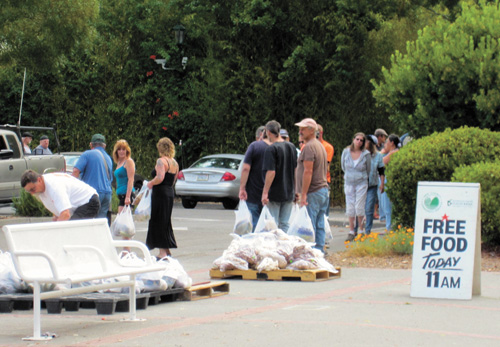Holidays have come and gone, need remains
The holidays have come and gone and taken with them the grand feasts prepared for the less fortunate, by the generous at heart.
And while Christmas trees and buildings adorned with bright lights have been phased out for the year, hungry people still remain.
To put it in perspective, the Redwood Empire Food Bank, Sonoma County’s largest hunger-relief organization, every month distributes food to 78,000 people. Of that amount, 34,000 are children and 11,300 are seniors. The remaining 13,500 recipients of the food bank are working families whose median monthly household income is $930, according to its Executive Director David Goodman who cited a study conducted by REFB called, “Hunger in Sonoma County, 2010.”
Hence, the food bank and the pantries throughout the county need donations now just as much as they did in November and December.
“Hunger doesn’t know the difference between Christmas, Thanksgiving or any other time of year,” Goodman said. “So after the holidays the big difference is the greater public celebration ends, yet the despair among hungry people continues.
“We live off the generosity of what happens during the holidays the first part of the year, but what we collect now provides us with the opportunities to feed people in the future. The support gives us the confidence to develop new programs, create new food sources, bring in food from outside the county via trucking, etc. We do a lot of different things here, but we don’t print money,” Goodman said.
The REFB is the only actual “food bank” in Sonoma County, but 166 non-profit or faith-based organizations in the county receive about 30 percent of its food. The other 70 percent gets distributed directly to people in need, courtesy of “many, many – thousands of volunteers,” Goodman said.
“We have a positive healthy relationship with all of the food pantries that we serve. We help them with their missions and they help us with ours,” Goodman said, referring to pantries not only in Sonoma County, but also Lake, Mendocino, Humboldt and Del Norte counties.
“The issue of hunger is much more in people’s awareness over the holidays because there’s much more written about it and people’s hearts are tugged more because they don’t want to imagine anyone not having that holiday meal,” said Food for Thought Deputy Executive Director and Client Services Manager Rachel Gardner.
Many food pantries, including Food for Thought, do need extra food over the holidays, because clients are often provided with food for their regular meals and in addition extra food for a special holiday meal, Gardner said.
“However, hunger is an issue all year long and we come back after the holidays and people’s needs are just as strong. Actually some people are doing even more poorly financially come January, because they have spent whatever little money they may have had over the holidays,” she said, noting Food for Thought was closed for a week between Christmas and New Year’s and – while people were given extra food to help get them through – by the time Jan. 2, came around there were people lined up at the door, because their cupboards were bare.
“One client said to me she had to tell her kids the day before, ‘we don’t have any bread. We have to wait until tomorrow until we can get back to the food bank,’” Gardner said, adding, “Not only do people not necessarily think about people being hungry throughout the year, but sometimes people forget that HIV is still an issue.”
Food for Thought serves any county resident diagnosed with HIV or AIDS, and their dependent children. Food for Thought is open five days a week – Tuesday through Saturday – for its clients – currently 675 – who can come in anytime during open hours and shop.
Healdsburg Shared Ministries food pantry serves about 3,000 Healdsburg/Geyserville residents on average, but notices a spike in recipients after the harvest, because there’s a lot of vineyard work going on in the area, said Susan Graf, a longtime and very active Healdsburg food pantry board member.
“Eighty percent of our cliental at the food pantry are working Hispanic individuals,” Graf said. “We also really keep an eye on our needy senior citizens. I personally feel there is a huge need for our seniors, because their pensions have not changed and everything else has gotten so expensive. We donate as much as we can to the Meals on Wheels program, and we run a twice-a-month senior bag program,” she said.
As with many other food pantries, Healdsburg’s is “always in need of money,” Graf said. “A lot of people don’t understand
that we need the money to buy the food from the Redwood Empire Food Bank, and most people like to drop off and give us canned goods, but we can buy food for about 18 cents a pound at the Redwood Empire Food Bank, so our dollar goes a long, long way (there),” she said, adding, “Ninety eight percent of every dollar given to us goes to buy food. We are completely volunteer-based.”
The Windsor Service Alliance food pantry serves about 600 Windsor residents a month. Board member Barbara Brown said the need always varies, but “hunger never takes a break.”









